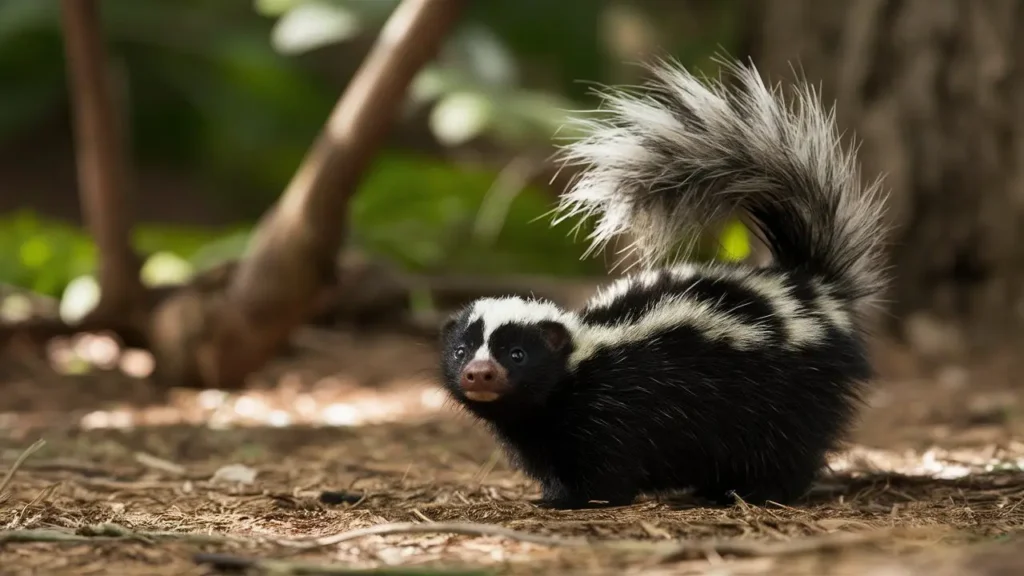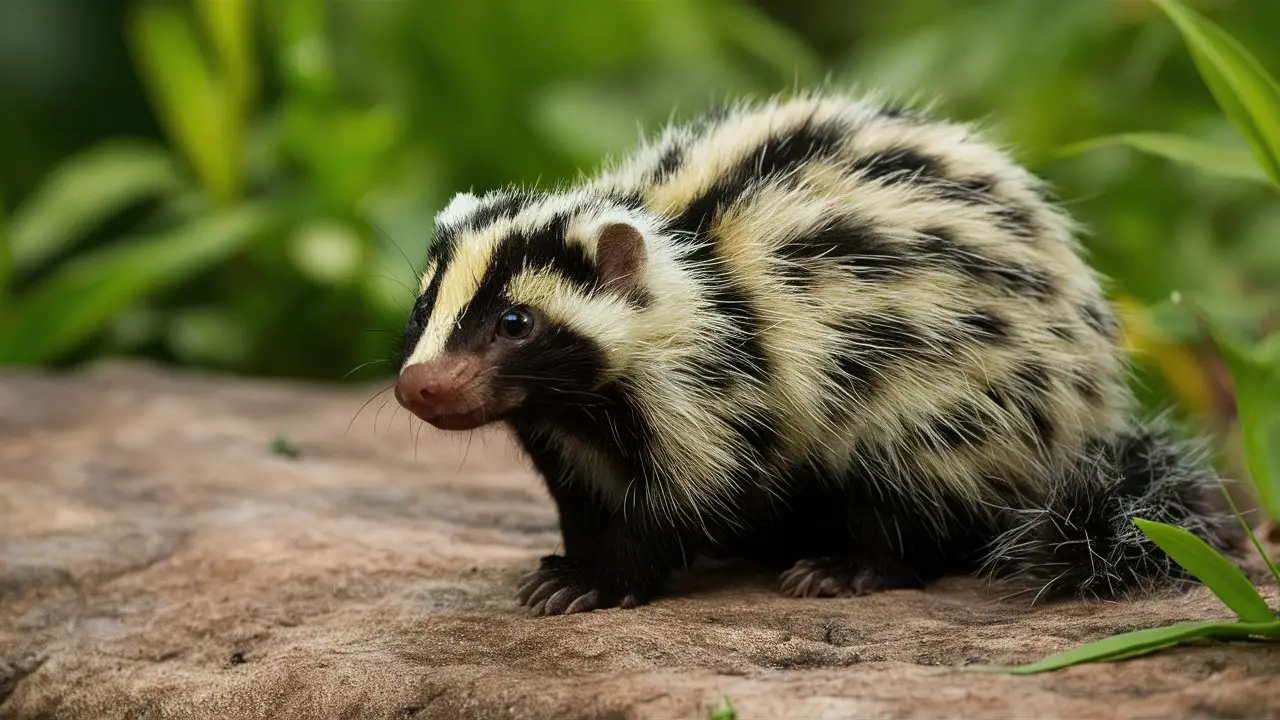Spotted Skunk Diet & Facts: What Fuels Them?
Last updated on March 7th, 2025 at 10:43 pm
Have you ever heard of the Pygmy Spotted Skunk? These tiny mammals are nature’s night-time wonders, known for their unique spotted patterns and fascinating behaviors. Scientifically named Spilogale pygmaea, this skunk species is one of the smallest in its family. From its intriguing diet to its clever defense tactics, the Pygmy Spotted Skunk is a true marvel of nature.
Introduction to the Pygmy Spotted Skunk
The Pygmy Spotted Skunk thrives in the forested and coastal areas of western Mexico. Its distinct black coat with white spots and stripes not only makes it visually striking but also helps deter predators. As nocturnal creatures, these skunks lead solitary lives, sneaking through the shadows to hunt and forage. Their small size, agility, and resourcefulness make them an essential part of the ecosystems they inhabit.
- Native Habitat: Forests of western Mexico, including brushland and coastal scrub.
- Size: Among the smallest skunks, with a compact body perfect for agility.
- Diet: Omnivorous, feasting on insects, fruits, small mammals, and eggs.
- Defense: Known for their dramatic handstand posture before releasing a potent spray.
Physical Characteristics
The Pygmy Spotted Skunk’s small size and distinct fur patterns set it apart from other skunks.
- Size: Typically 18–22 cm (7–9 inches) in body length, with a bushy tail adding another 10–15 cm (4–6 inches).
- Weight: Ranges between 200–400 grams (7–14 ounces).
- Fur Pattern: Black fur adorned with white spots and broken stripes, making each skunk uniquely marked.
Adaptations for Survival
Potent Spray: Their sulfur-based chemical defense can reach several feet, effectively deterring even larger predators.
Agile Movements: Their small frame and quick reflexes allow them to escape predators and navigate rocky or dense terrain.
Climbing Ability: Pygmy spotted skunks are excellent climbers, often scaling trees to raid nests or evade threats.

Habitat and Range
The Pygmy Spotted Skunk is native to Mexico, where it inhabits a variety of environments.
Preferred Habitats
- Coastal Scrub: Provides cover and access to food sources.
- Wooded Streams and Brushland: Offers shelter and protection from predators.
- Tropical Forests: Dense vegetation helps them remain hidden during the day.
Geographic Range
These skunks are found primarily in western Mexico, with significant populations in:
- Southern Sinaloa
- Nayarit
- Jalisco
Behavioral Traits
Social Structure
Pygmy Spotted Skunks are solitary animals. They interact with others only during mating season. Mothers raise their kits alone, teaching them vital survival skills before they become independent.
Defensive Strategies
The Pygmy Spotted Skunk employs a range of behaviors to protect itself:
Escape Tactics: Uses its agility to climb or retreat into dense vegetation..
Handstand Display: Raises its body on its front legs, showcasing its warning colors.
Chemical Spray: Releases a foul-smelling liquid from specialized glands, with accuracy over several feet.

Dietary Habits
The Pygmy Spotted Skunk has an omnivorous diet, ensuring survival across various seasons.
Primary Food Sources
- Insects: Beetles, crickets, and moth larvae make up a significant part of their diet.
- Small Mammals: Rodents and voles provide essential protein.
- Fruits and Berries: A sweet treat that offers vitamins and fiber.
- Eggs: Stolen from bird or reptile nests for a nutrient boost.
Hunting Techniques
- Stealth: Creeps silently to surprise prey.
- Digging: Uses strong claws to unearth insects and larvae.
- Climbing: Scales trees to access nests or higher food sources.
Reproduction and Lifespan
The life cycle of the Pygmy Spotted Skunk is both fascinating and brief.
Mating and Offspring
- Breeding Season: Occurs once a year, typically in late winter.
- Gestation Period: Around 50 days.
- Litter Size: Usually 2–5 kits, born blind and helpless.
- Weaning: Kits begin foraging with their mother by 6–8 weeks.
- Independence: Achieved by 3–4 months, when the young leave to establish their own territories.
Lifespan
In the wild, these skunks live 2–4 years on average. Their longevity is influenced by predation, habitat conditions, and food availability.
Conservation Status
Threats to Survival
The Pygmy Spotted Skunk faces several challenges:
- Habitat Loss: Deforestation and urbanization reduce their living spaces.
- Predation: Owls, coyotes, and other predators pose constant threats.
- Human Activity: Roadkill incidents and pesticide exposure impact their populations.
Conservation Efforts
Efforts to protect this species include:
Community Education: Raising awareness about the importance of skunks in pest control and ecosystem balance.e learning from our planet’s small wonders.
Habitat Preservation: Establishing protected areas to prevent habitat destruction.
Research: Studying their behavior and ecological roles to develop effective conservation strategies.
Fun Facts About Pygmy Spotted Skunks
- Tiny but Mighty: Despite their size, their spray is as potent as that of larger skunks.
- Acrobatic Defense: Their handstand display is unique among skunks.
- Nocturnal Lifestyle: They are most active at night, avoiding predators and competition.
- Role in Pest Control: By eating insects and rodents, they help maintain ecological balance.
- Omnivorous Diet: Their adaptability allows them to survive in changing environments.
Frequently Asked Questions
What do Pygmy Spotted Skunks eat?
They eat insects, small mammals, fruits, berries, and eggs, adapting their diet to seasonal availability.
Where do Pygmy Spotted Skunks live?
They are native to western Mexico, inhabiting coastal scrub, brushland, and tropical forests.
How do Pygmy Spotted Skunks defend themselves?
They perform a handstand display and release a sulfur-based spray to deter predators.
Conclusion
The Pygmy Spotted Skunk is a testament to nature’s diversity and adaptability. From its acrobatic defense to its nocturnal foraging, this tiny creature plays a significant role in its ecosystem. Protecting these skunks ensures the survival of a species that contributes to pest control, seed dispersal, and ecological balance. By learning more about them, we can appreciate the wonders of the natural world and the importance of conserving even its smallest inhabitants.

